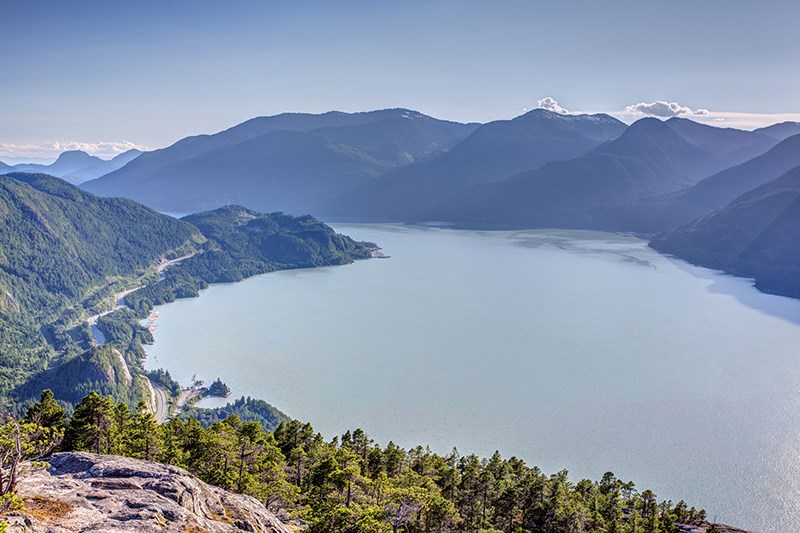The Village of Lions Bay council has adopted a resolution calling for a ban on liquefied natural gas (LNG) tankers in Howe Sound.
The move, taken last Wednesday (May 21), will see village officials send a letter to Prime Minister Stephen Harper and Premier Christy Clark calling for a ban on tanker traffic, mostly because of safety concerns, Mayor Brenda Broughton told The Chief on Monday (May 26).
The vote came after a presentation by Eion Finn, a member of the group My Sea to Sky, focussing on LNG tanker safety, especially the risk of explosion in the event of a collision with another vessel.
The exact wording of the resolution won’t be known until it’s included in the minutes of the next meeting, Broughton said. However, the mayor said she and her colleagues found the part about what could happen in the event of an accident compelling.
“Council has discussed and been concerned about safety in the past, so this [resolution] is another indication that we’re concerned about safety on the sound,” she said. “Eion highlighted the issues surrounding a tanker accident and what the kill zone would be if there were an accident.”
Finn told The Chief while the likelihood of a collision causing an explosion in Howe Sound is remote, “unlikely things happen.” He said a recent University of Washington study warned against increasing traffic involving what he called “Grade A tankers” such as vessels carrying LNG in narrow shipping lanes such as Haro Strait between San Juan Island and the Saanich Peninsula.
“The study said a wind-driven plume fire, if the gas hits an ignition source, would kill everyone within 1.6 kilometres and severe third-degree burns will be experienced for up to 3.5 kilometres,” he said.
Broughton said that could be a concern for those on land in a number of locations in the sound. Even without such a catastrophic mishap, she said, the wash from LNG tankers 300 metres long could significantly affect beach-front areas around the sound.
“You’ve got Anvil Island, near Lions Bay, and then Bowyer Island… a tanker is not always going to be in the middle of Howe Sound. It has to be on one side or the other, and as it gets to Horseshoe Bay and Bowen Island, there’s just no way for it to avoid those narrow passages,” she said.
Broughton said it’s her personal feeling that continuing the recovery of the Howe Sound ecosystem — supporting the return of whales and dolphins and 2013’s first commercial salmon fishery in the sound in more than 50 years — has great economic value to the region.
When it was first proposed, Broughton said she felt the Woodfibre project would be “relatively benign” from an environmental and safety point of view. But the more she looks into the science, the more wary she becomes, she said.
“This is a thriving, spectacular future that Howe Sound has,” she said. “It’s just a jewel, and I see that as a multi-billion dollar enterprise — between the new gondola and the filming that’s routinely done in the Sea to Sky Corridor, to the attractions at Whistler. It’s just a gem.”
Finn and Byng Giraud, Woodfibre LNG’s vice president of government relations, both made presentations to the Squamish-Lillooet Regional District (SLRD) board at its monthly meeting in Pemberton on Monday (May 26). The board took no action on Finn’s request, referring the matter back to staff pending receipt of more information about the plant’s potential impacts.
“I don’t make decisions based on hypotheses. I make decisions based on fact and I’m of a mind that we don’t have nearly the information that we need to decide,” Area D director Maurice Freitag told The Chief on Tuesday (May 27).
“Both LNG presentations were very well presented and inspired quite a few questions from the board,” Patricia Heintzman, SLRD board chair and Squamish director, wrote in an email after the meeting.
“There is still so much information that needs to be provided on this project.”
The Squamish Nation has yet to take a position on the project. “Squamish Nation Chiefs and Council are currently reviewing the project and ensuring that the Nation’s title and rights are recognized and protected,” an official wrote in a statement.
Woodfibre LNG proponents, meanwhile, last week responded to comments from My Sea to Sky about a purported subsidy on the price of electricity that proponents would receive if the project goes ahead. In a May 15 article in The Chief, Finn said the reduced rate that the proponents are likely to pay would result in increased hydro rates for residential customers.
Finn this week reiterated his contention the drawbacks outweigh the economic benefits of such a project by a significant margin.
In a letter to The Chief, Giraud wrote that the B.C. government’s framework for such projects “requires that LNG policy on power rates for LNG projects protect existing ratepayers.”
— With files from Rebecca Aldous, The Chief



